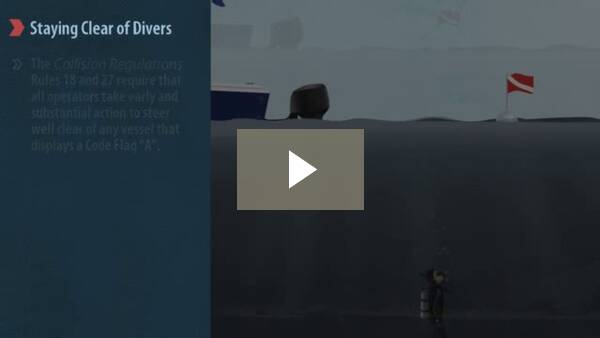Over 10 million boaters enjoy Canada’s waterways each year. All boaters should be knowledgeable of, and abide by, the Collision Regulations and use common sense and courtesy while underway.
Never create a hazard or stress to yourself, to your fellow operators or to the local habitat:
- Never operate close to swimmers and the personal property of others
- Ensure that your wake and wash will not cause personal injury, erosion of the shoreline or damage to personal property
- Use common sense and courtesy and reduce your vessel’s wake when passing small non-powered boats such as canoes, kayaks and rowboats, as they can be easily swamped and capsized by your wake
Operating Near Swimmers
Operating a motorized boat near swimmers on Canada’s waterways is extremely dangerous and against the law. Always keep well away from designated swimming areas.
Swimming areas in Canada are designated by swimming buoys that are white in colour. However, not all swimming areas may be marked. When operating near shore, keep a lookout for swimmers, including those persons engaged in underwater activities such as snorkelling or diving.
Safe Boating Tip
Remember that the sun’s glare can make it difficult to spot swimmers in the water.
Staying Clear of Divers
Vessels and persons engaged in diving activities are required to display flags indicating their activities on Canada’s waterways.
The boat from which divers are diving may display the blue and white Code Flag ‘A’ which indicates, ‘I have a diver down: keep well clear at slow speed.’ The Collision Regulations Rules 18 and 27 require that all operators take early and substantial action to steer well clear of any vessel that displays a Code Flag ‘A’.
A red and white diving flag (carried on the top of a white buoy) marks an area where diving is in progress. Always be sure to keep a lookout for and steer clear of diving flags.
Safe Boating Tip
The red and white diving flag marks the general area where diving is in progress. Keep in mind that it is easy for divers to stray from the area marked by a diving buoy. Always exercise extreme care, slow down and avoid boating in waters frequented by divers.
Wake and Wash
Operators are responsible for the wake and wash of their craft:
- Wake is caused by the boat moving through the water and displacing it
- Wash is the disrupted water following from the stern of the boat and is caused by the motion of the propeller
A number of provinces have adopted a province-wide speed limit of 10 km/h within 30 metres of shore. Although not posted, these speed limits are in effect on inland waterways. Some exceptions apply, such as when towing a water-skier or operating in rivers less than 100 m wide. As of the date of printing, these speed limits apply in Alberta, Manitoba, Saskatchewan, Ontario and British Columbia. Boaters should check with their provincial authorities for more information.
Reducing the Effects of Wake and Wash
Your craft’s wake and wash can cause damage to the shoreline and can be a danger to smaller craft. When operating your craft be aware of the effects of your wake and wash on the following:
- Swimmers and bathing areas
- Docks
- Wildlife
- Shoreline erosion
- Smaller craft (such as fishing boats)
- Non-powered craft (such as canoes)
- Water-skiers
- Divers
- Areas of anchorage
- Other anchored or grounded vessels
If operating in or near such areas you should adjust the speed of your craft to reduce the effects of wake and wash. Doing so will ensure that you avoid the risk of personal injury, shoreline erosion and damage to personal property.






